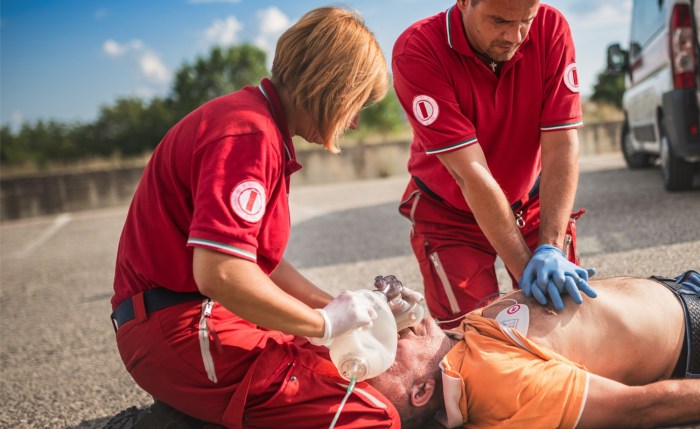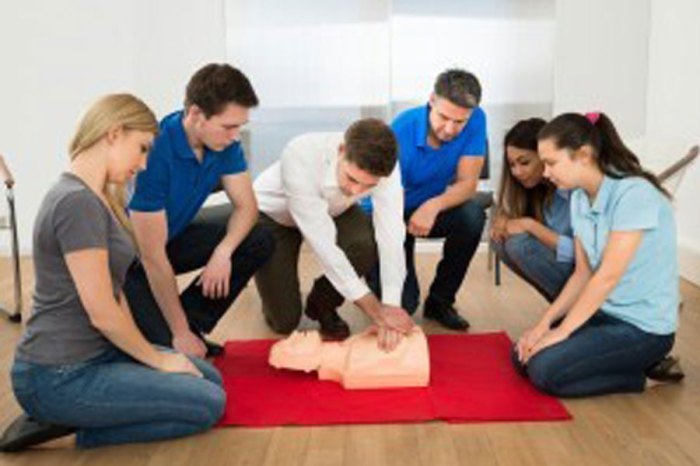
With Emergency Care and First Aid Training at the forefront, this paragraph opens a window to an amazing start and intrigue, inviting readers to embark on a storytelling journey filled with unexpected twists and insights.
Emergency situations can strike at any time, and being equipped with the right skills can make a life-saving difference. From CPR to wound care, this training prepares individuals to respond confidently and effectively in critical moments.
Importance of Emergency Care and First Aid Training
Emergency care and first aid training are crucial skills that can make a significant difference in saving lives during critical situations. Being trained in these areas equips individuals with the knowledge and skills needed to provide immediate assistance when someone is injured or suddenly falls ill.
Immediate Response
One of the key benefits of emergency care and first aid training is the ability to provide quick and effective responses in emergency situations. This timely intervention can prevent a condition from worsening and can even mean the difference between life and death.
Reducing Severity of Injuries
By knowing how to administer first aid properly, individuals can help reduce the severity of injuries or illnesses before professional medical help arrives. This can significantly improve the outcome for the affected individual and increase their chances of recovery.
Key Skills Taught in Emergency Care Training
In emergency care and first aid training, individuals learn a variety of essential skills that are crucial for responding to emergencies effectively. These skills not only save lives but also empower individuals to take immediate action in critical situations.
CPR (Cardiopulmonary Resuscitation)
- Performing CPR is a vital skill taught in emergency care training as it helps maintain blood circulation and oxygenation in the body of a person experiencing cardiac arrest.
- Knowing how to perform CPR correctly can significantly increase the chances of survival for someone in need of immediate assistance.
Wound Care
- Proper wound care techniques are essential to prevent infection and promote healing.
- Individuals learn how to clean and dress wounds appropriately to reduce the risk of complications.
Handling Fractures
- Learning how to immobilize and support fractures is critical to prevent further injury and reduce pain for the injured person.
- Individuals are taught how to apply splints and provide support until professional medical help arrives.
Simulation Exercises in Training
Simulation exercises play a crucial role in emergency care training by providing a realistic environment for students to practice their skills in simulated emergency situations. These exercises help prepare individuals to respond effectively in real-life scenarios, enhancing their readiness and ability to make quick decisions under pressure.
Benefits of Practicing Scenarios
- Simulation exercises allow trainees to apply theoretical knowledge in a practical setting, reinforcing learning and retention of skills.
- By practicing scenarios like cardiac arrest or choking, individuals gain confidence in their abilities to assess and respond to emergencies.
- These exercises also help improve communication and teamwork among responders, ensuring a coordinated and efficient response.
- Through simulations, trainees can identify gaps in their knowledge and skills, allowing for targeted improvement and further training.
Enhancing Readiness and Decision-Making
Simulations enhance readiness by exposing individuals to the stress and urgency of real emergency situations in a controlled setting. This exposure helps build resilience and adaptability, preparing responders to remain calm and focused when faced with actual crises. Additionally, practicing scenarios repeatedly through simulations improves decision-making skills under pressure, enabling individuals to make quick and effective choices in high-stress environments.
Common Emergency Situations Covered
In first aid training, individuals are taught to handle a variety of common emergency situations effectively. This training equips them with the necessary skills and knowledge to provide immediate care and support in times of crisis.
Burns
- For minor burns, the appropriate response includes cooling the affected area with cold water and covering it with a sterile bandage.
- For more severe burns, individuals are trained to call emergency services immediately and keep the burn area clean and covered until help arrives.
Cuts
- Individuals learn to clean the wound with mild soap and water, apply pressure to stop bleeding, and cover it with a sterile bandage.
- In cases of deep or severe cuts, they are trained to seek medical help promptly to prevent infection and further complications.
Sprains
- First aid training covers the proper technique for applying ice and compression to reduce swelling and pain in case of a sprain.
- Individuals are taught to immobilize the injured area and seek medical attention if the pain or swelling persists.
Certification and Renewal Process

In emergency care and first aid training, obtaining certification is a crucial step to showcase competency in providing immediate medical assistance during emergencies. Certification serves as validation of the skills and knowledge acquired through the training process.
Certification Process
- Upon completion of the training program, participants are required to pass a certification exam to demonstrate their understanding of emergency care procedures and protocols.
- Successful completion of the exam leads to the issuance of a certification that is recognized in the field of emergency medical services.
Importance of Renewing Certifications
Renewing certifications regularly is essential to ensure that individuals are up-to-date with the latest advancements in emergency care and first aid techniques. As medical practices evolve, it is crucial for certified individuals to refresh their knowledge and skills to deliver effective care.
Certification Validity and Renewal Requirements
- Certifications in emergency care and first aid typically have a validity period of 2 years.
- To renew their certification, individuals are required to undergo refresher training to stay current with best practices and guidelines.
- Renewal may also involve passing a recertification exam to assess proficiency and competence in emergency care procedures.
Workplace First Aid Requirements

In the workplace, first aid requirements are essential to ensure the safety and well-being of employees. Employers have a legal obligation to provide a safe working environment, which includes having adequate first aid provisions in place.
Role of Employers in Ensuring Staff are Trained in Emergency Care
- Employers are responsible for assessing the first aid needs in the workplace based on the size of the workforce, the nature of the work, and the risks involved.
- They must ensure that there are an adequate number of trained first aiders available at all times.
- Employers should provide access to first aid training for employees to equip them with the necessary skills to respond to emergencies.
Designated First Aiders and Emergency Response Plans
- Designated first aiders are individuals within the organization who have received specific first aid training and are responsible for providing immediate assistance in case of an emergency.
- Emergency response plans Artikel the procedures to be followed in the event of an emergency, including the roles and responsibilities of designated first aiders.
- Regular drills and training sessions are conducted to ensure that employees are familiar with the emergency response plans and can act swiftly in critical situations.
In conclusion, Emergency Care and First Aid Training play a crucial role in equipping individuals with the necessary skills to handle emergencies effectively. From simulation exercises to certification processes, this training ensures readiness and quick response when it matters the most. Stay prepared, stay safe.
FAQ Resource
What is the importance of Emergency Care and First Aid Training?
Emergency Care and First Aid Training are crucial as they empower individuals to respond effectively in life-threatening situations, potentially saving lives.
What are some key skills taught in this training?
Skills such as CPR, wound care, and fracture handling are essential components of Emergency Care and First Aid Training, enabling individuals to provide immediate assistance.
How do simulation exercises benefit training?
Simulation exercises help individuals practice responding to emergencies like cardiac arrest or choking, enhancing readiness and decision-making skills under pressure.
What are common emergency situations covered in the training?
Training addresses scenarios like burns, cuts, and sprains, providing individuals with the knowledge to handle a variety of emergencies effectively.
Why is certification and renewal important?
Certification ensures that individuals are trained and knowledgeable in emergency care, while renewal maintains up-to-date skills and knowledge.





